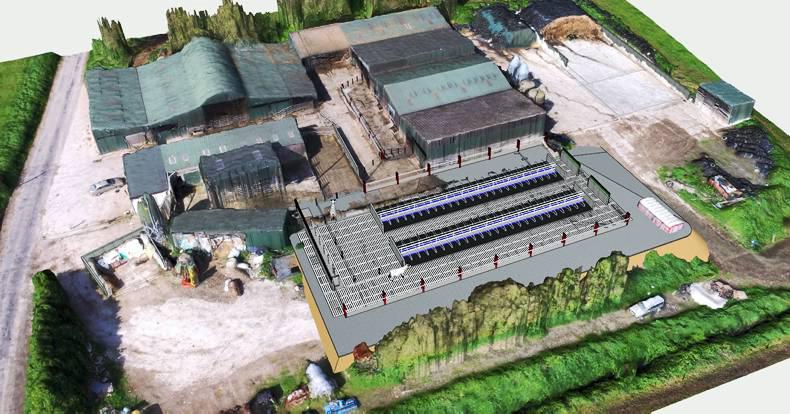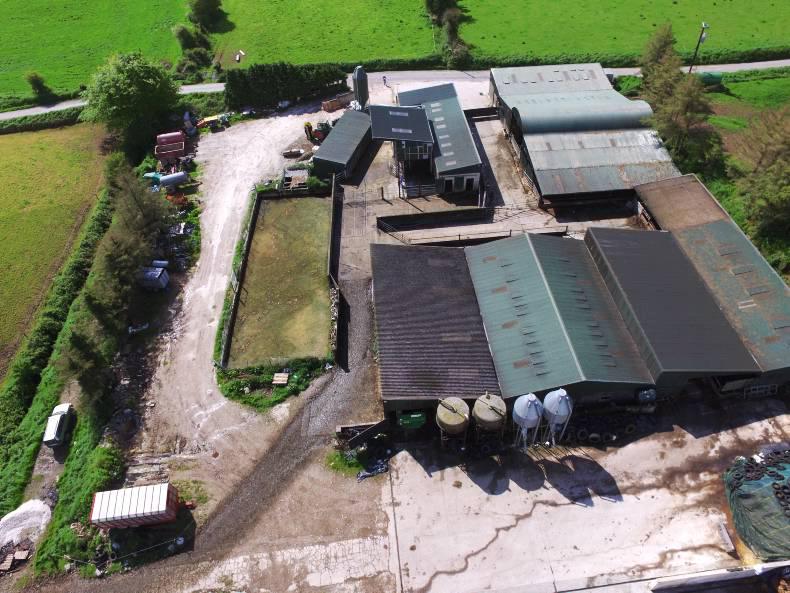The most important stage in building any shed is the planning. It is at this point that you can discuss what will work and what won’t. It is also at this stage that time can be spent to ensure that the design is making the most use of the space available on your farmyard, in the most efficient way.
Crucially, it is at this stage that changes can be made.
There is little use wanting to make a change when the tank has been put in or when the first wall is poured. At this point, many farmers will spot a complication that will arise due to the positioning of the shed and a gap that you originally believed big enough to herd cattle through is now too small, for example.
This is not completely the farmer’s fault as many people will simply find it difficult to visualise a proposed building from looking at a 2D plan.
There are ways around this, however, and Francis Quigley of Riverhouse Agri, who specialises in farmyard design and planning, explains to me how it is possible to see your new shed on your existing farmyard from the comfort of your kitchen.
Pictures one, two and three

For nearly 10 years, Francis has been using 3D models for specialist design work to show farmers what their new shed is going to look like on their existing yard. Francis will design exactly what the new shed is going to look like using CAD (computer-aided design) software. This allows him to build an exact replica of the proposed shed, allowing the farmer to easily make any changes that they wish.

These 3D models will be extremely detailed, including features such as gutters, drain pipes, steel frames, slats, agitation points, individual cubicles, the crush and head gate, all of which can be clearly seen in the design.

More advanced sheds can also be designed, as seen in picture three. This shed is specially designed to accommodate two robotic milking machines. A lot of planning was involved to accommodate the two robots as entry and exit points to the shed are crucial to ensure efficient flow of cows through the robots.
Pictures four, five and six
Where Francis really sets himself apart from other farm designers is when it comes to fitting that new shed into a farmer’s specific farmyard. Francis will fly a drone above the farmyard, continually taking pictures which are uploaded to an online system to form an accurate 3D model of the property. This 3D model will include buildings, trees, machinery and even drains in great detail.

There are certain things that the software will struggle with, such as some vertical free-standing walls, but Francis is easily able to add these to the model afterwards due to his experience of using such software.
Once he has this model completed he is then able to import the newly designed shed on to the existing farmyard. It is here that farmers get the real benefit as they do not have to try to visualise how the new shed is going to fit into their existing farmyard as they can see it and virtually move through the shed.

The ability to rotate and zoom around the farmyard allows the farmer to see exactly how the shed will fit. The farmer can also see precisely how the building is going to work, the movement of cows, the movement of machinery for feeding and the access for slurry tankers, for example.

It allows farmers to see how their existing farmyard is going to be affected.It is easy for farmers to see if roadways or access routes for cows will have to be altered. This system not only allows the farmer greater control when designing a new shed but allows them to design their farmyard in a way that suits their current system.
Once Francis has designed the farmyard to suit the farmer’s requirements and incorporated the new shed into the design, he will record a video talking through the design and where changes can be made. He will also look at what works and does not work with the design and give the farmer the opportunity to consider all his options before moving on to the next stage of the project.
In this video he will go into great detail about what alterations can be made to the original design to make the most use of the space available. It can be clearly seen if pillars need to move to allow access for a diet feeder, for example. Without the use of the 3D modelling, these obstructions may not be seen until the building work has commenced and then more investment must be made to correct what would have been a simple problem to spot if 3D imaging had been used.
Francis’s view
 Francis is a qualified agricultural engineer. He comes from a farming background, which gives him an advantage when designing a shed as he not only looks at the architectural side of things but the practical side and how cattle and machinery move through and around the shed.
Francis is a qualified agricultural engineer. He comes from a farming background, which gives him an advantage when designing a shed as he not only looks at the architectural side of things but the practical side and how cattle and machinery move through and around the shed.
“Designing a farm building is very different to designing a house. Cow movement can be very difficult to predict. Everything needs to be exact if a farmer is trying to move cows out of a calving house to another pen safely and quickly without needing help,” according to Francis.
“Farmers will generally only build a new shed once or twice in a generation and can sometimes rush into it a bit. I would encourage farmers to consult with the builder and their agricultural adviser on the design of the proposed shed because ultimately, the more opinions you have the better your design will be.”
Cost
The total for the farm yard design service that Francis provides is around €900. This includes coming out to survey the site with the use of both the drone and by taking detailed measurements of the site. He will discuss the shed layout ensuring it meets the farmer’s requirements.
At this point he will record a video going through every aspect of the shed in detail and highlighting any concerns he has for certain aspects of the design. He will then meet with the farmer again to address these concerns until a design that suits the farmer and the system is agreed upon.
At this stage the farmer will give feedback on any aspect of the design he wishes to change. Francis will make any required alterations and incorporate the newly designed shed into the existing farmyard. Francis also provides planning application services, whereby he will take the final design and prepare the necessary planning drawings and application forms and submit them to the local county council for approval.
For more information, visit the website www.riverhouseagri.com.












SHARING OPTIONS